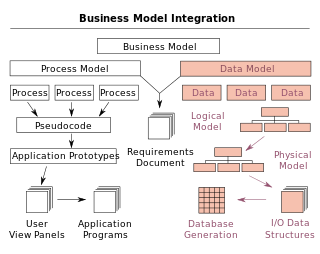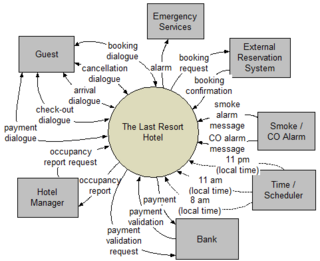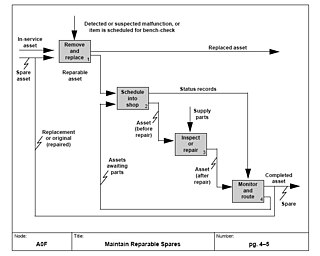
The Unified Modeling Language (UML) is a general-purpose, developmental modeling language in the field of software engineering that is intended to provide a standard way to visualize the design of a system.
The waterfall model is a breakdown of project activities into linear sequential phases, meaning they are passed down onto each other, where each phase depends on the deliverables of the previous one and corresponds to a specialization of tasks. The approach is typical for certain areas of engineering design. In software development, it tends to be among the less iterative and flexible approaches, as progress flows in largely one direction through the phases of conception, initiation, analysis, design, construction, testing, deployment and maintenance.

A data model is an abstract model that organizes elements of data and standardizes how they relate to one another and to the properties of real-world entities. For instance, a data model may specify that the data element representing a car be composed of a number of other elements which, in turn, represent the color and size of the car and define its owner.

The spiral model is a risk-driven software development process model. Based on the unique risk patterns of a given project, the spiral model guides a team to adopt elements of one or more process models, such as incremental, waterfall, or evolutionary prototyping.
Software design is the process by which an agent creates a specification of a software artifact intended to accomplish goals, using a set of primitive components and subject to constraints. Software design may refer to either "all the activity involved in conceptualizing, framing, implementing, commissioning, and ultimately modifying complex systems" or "the activity following requirements specification and before programming, as ... [in] a stylized software engineering process."
Software development is the process of conceiving, specifying, designing, programming, documenting, testing, and bug fixing involved in creating and maintaining applications, frameworks, or other software components. Software development involves writing and maintaining the source code, but in a broader sense, it includes all processes from the conception of the desired software through to the final manifestation of the software, typically in a planned and structured process. Software development also includes research, new development, prototyping, modification, reuse, re-engineering, maintenance, or any other activities that result in software products.
In software and systems engineering, the phrase use case is a polyseme with two senses:
- A usage scenario for a piece of software; often used in the plural to suggest situations where a piece of software may be useful.
- A potential scenario in which a system receives an external request and responds to it.
A business process, business method or business function is a collection of related, structured activities or tasks by people or equipment in which a specific sequence produces a service or product for a particular customer or customers. Business processes occur at all organizational levels and may or may not be visible to the customers. A business process may often be visualized (modeled) as a flowchart of a sequence of activities with interleaving decision points or as a process matrix of a sequence of activities with relevance rules based on data in the process. The benefits of using business processes include improved customer satisfaction and improved agility for reacting to rapid market change. Process-oriented organizations break down the barriers of structural departments and try to avoid functional silos.

In systems engineering, information systems and software engineering, the systems development life cycle (SDLC), also referred to as the application development life-cycle, is a process for planning, creating, testing, and deploying an information system. The systems development life cycle concept applies to a range of hardware and software configurations, as a system can be composed of hardware only, software only, or a combination of both. There are usually six stages in this cycle: requirement analysis, design, development and testing, implementation, documentation, and evaluation.
Structured Systems Analysis and Design Method (SSADM) is a systems approach to the analysis and design of information systems. SSADM was produced for the Central Computer and Telecommunications Agency, a UK government office concerned with the use of technology in government, from 1980 onwards.

Business process modeling (BPM) in business process management and systems engineering is the activity of representing processes of an enterprise, so that the current business processes may be analyzed, improved, and automated. BPM is typically performed by business analysts, who provide expertise in the modeling discipline; by subject matter experts, who have specialized knowledge of the processes being modeled; or more commonly by a team comprising both. Alternatively, the process model can be derived directly from events' logs using process mining tools.
A data-flow diagram is a way of representing a flow of data through a process or a system. The DFD also provides information about the outputs and inputs of each entity and the process itself. A data-flow diagram has no control flow — there are no decision rules and no loops. Specific operations based on the data can be represented by a flowchart.
A conceptual model is a representation of a system. It consists of concepts used to help people know, understand, or simulate a subject the model represents. In contrast, physical models are physical object such as a toy model that may be assembled and made to work like the object it represents.

Business Process Model and Notation (BPMN) is a graphical representation for specifying business processes in a business process model.
Joint application design (JAD) is a process used in the life cycle area of the dynamic systems development method (DSDM) to collect business requirements while developing new information systems for a company. "The JAD process also includes approaches for enhancing user participation, expediting development, and improving the quality of specifications." It consists of a workshop where "knowledge workers and IT specialists meet, sometimes for several days, to define and review the business requirements for the system." The attendees include high level management officials who will ensure the product provides the needed reports and information at the end. This acts as "a management process which allows Corporate Information Services (IS) departments to work more effectively with users in a shorter time frame".

In software engineering, structured analysis (SA) and structured design (SD) are methods for analyzing business requirements and developing specifications for converting practices into computer programs, hardware configurations, and related manual procedures.

Event partitioning is an easy-to-apply systems analysis technique that helps the analyst organize requirements for large systems into a collection of smaller, simpler, minimally-connected, easier-to-understand "mini systems" / use cases.

Misuse case is a business process modeling tool used in the software development industry. The term Misuse Case or mis-use case is derived from and is the inverse of use case. The term was first used in the 1990s by Guttorm Sindre of the Norwegian University of Science and Technology, and Andreas L. Opdahl of the University of Bergen, Norway. It describes the process of executing a malicious act against a system, while use case can be used to describe any action taken by the system.

In systems engineering, software engineering, and computer science, a function model or functional model is a structured representation of the functions within the modeled system or subject area.

IDEF6 or Integrated Definition for Design Rationale Capture is a method to facilitate the acquisition, representation, and manipulation of the design rationale used in the development of enterprise systems. This method, that wants to define the motives that drive the decision-making process, is still in development. Rationale is the reason, justification, underlying motivation, or excuse that moved the designer to select a particular strategy or design feature. More simply, rationale is interpreted as the answer to the question, “Why is this design being done in this manner?” Most design methods focus on what the design is.









